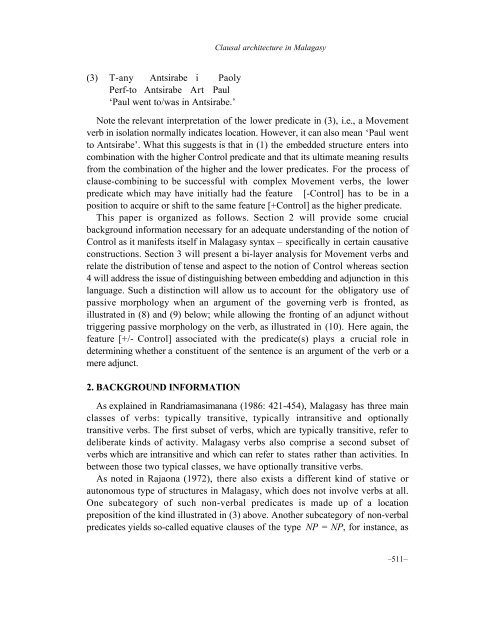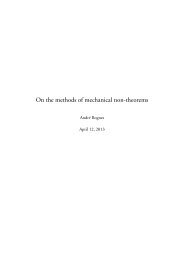Clausal architecture and movement verbs in Malagasy
Clausal architecture and movement verbs in Malagasy
Clausal architecture and movement verbs in Malagasy
Create successful ePaper yourself
Turn your PDF publications into a flip-book with our unique Google optimized e-Paper software.
(3) T-any Antsirabe i Paoly<br />
Perf-to Antsirabe Art Paul<br />
‘Paul went to/was <strong>in</strong> Antsirabe.’<br />
<strong>Clausal</strong> <strong>architecture</strong> <strong>in</strong> <strong>Malagasy</strong><br />
Note the relevant <strong>in</strong>terpretation of the lower predicate <strong>in</strong> (3), i.e., a Movement<br />
verb <strong>in</strong> isolation normally <strong>in</strong>dicates location. However, it can also mean ‘Paul went<br />
to Antsirabe’. What this suggests is that <strong>in</strong> (1) the embedded structure enters <strong>in</strong>to<br />
comb<strong>in</strong>ation with the higher Control predicate <strong>and</strong> that its ultimate mean<strong>in</strong>g results<br />
from the comb<strong>in</strong>ation of the higher <strong>and</strong> the lower predicates. For the process of<br />
clause-comb<strong>in</strong><strong>in</strong>g to be successful with complex Movement <strong>verbs</strong>, the lower<br />
predicate which may have <strong>in</strong>itially had the feature [-Control] has to be <strong>in</strong> a<br />
position to acquire or shift to the same feature [+Control] as the higher predicate.<br />
This paper is organized as follows. Section 2 will provide some crucial<br />
background <strong>in</strong>formation necessary for an adequate underst<strong>and</strong><strong>in</strong>g of the notion of<br />
Control as it manifests itself <strong>in</strong> <strong>Malagasy</strong> syntax – specifically <strong>in</strong> certa<strong>in</strong> causative<br />
constructions. Section 3 will present a bi-layer analysis for Movement <strong>verbs</strong> <strong>and</strong><br />
relate the distribution of tense <strong>and</strong> aspect to the notion of Control whereas section<br />
4 will address the issue of dist<strong>in</strong>guish<strong>in</strong>g between embedd<strong>in</strong>g <strong>and</strong> adjunction <strong>in</strong> this<br />
language. Such a dist<strong>in</strong>ction will allow us to account for the obligatory use of<br />
passive morphology when an argument of the govern<strong>in</strong>g verb is fronted, as<br />
illustrated <strong>in</strong> (8) <strong>and</strong> (9) below; while allow<strong>in</strong>g the front<strong>in</strong>g of an adjunct without<br />
trigger<strong>in</strong>g passive morphology on the verb, as illustrated <strong>in</strong> (10). Here aga<strong>in</strong>, the<br />
feature [+/- Control] associated with the predicate(s) plays a crucial role <strong>in</strong><br />
determ<strong>in</strong><strong>in</strong>g whether a constituent of the sentence is an argument of the verb or a<br />
mere adjunct.<br />
2. BACKGROUND INFORMATION<br />
As expla<strong>in</strong>ed <strong>in</strong> R<strong>and</strong>riamasimanana (1986: 421-454), <strong>Malagasy</strong> has three ma<strong>in</strong><br />
classes of <strong>verbs</strong>: typically transitive, typically <strong>in</strong>transitive <strong>and</strong> optionally<br />
transitive <strong>verbs</strong>. The first subset of <strong>verbs</strong>, which are typically transitive, refer to<br />
deliberate k<strong>in</strong>ds of activity. <strong>Malagasy</strong> <strong>verbs</strong> also comprise a second subset of<br />
<strong>verbs</strong> which are <strong>in</strong>transitive <strong>and</strong> which can refer to states rather than activities. In<br />
between those two typical classes, we have optionally transitive <strong>verbs</strong>.<br />
As noted <strong>in</strong> Rajaona (1972), there also exists a different k<strong>in</strong>d of stative or<br />
autonomous type of structures <strong>in</strong> <strong>Malagasy</strong>, which does not <strong>in</strong>volve <strong>verbs</strong> at all.<br />
One subcategory of such non-verbal predicates is made up of a location<br />
preposition of the k<strong>in</strong>d illustrated <strong>in</strong> (3) above. Another subcategory of non-verbal<br />
predicates yields so-called equative clauses of the type NP = NP, for <strong>in</strong>stance, as<br />
–511–

















